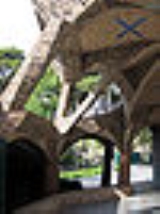
Church of Colònia Güell
Encyclopedia

Unfinished building
An unfinished building is a building where construction work was abandoned or on-hold at some stage or only exists as a design...
work by Antoni Gaudí
Antoni Gaudí
Antoni Gaudí i Cornet was a Spanish Catalan architect and figurehead of Catalan Modernism. Gaudí's works reflect his highly individual and distinctive style and are largely concentrated in the Catalan capital of Barcelona, notably his magnum opus, the Sagrada Família.Much of Gaudí's work was...
. It was built as a place of worship for the people in a manufacturing suburb in Santa Coloma de Cervelló
Santa Coloma de Cervelló
Santa Coloma de Cervelló is a municipality situated in the comarca of Baix Llobregat, at the province of Barcelona, Catalonia, Spain. The town has 7081 people....
, near Barcelona
Barcelona
Barcelona is the second largest city in Spain after Madrid, and the capital of Catalonia, with a population of 1,621,537 within its administrative limits on a land area of...
(Spain
Spain
Spain , officially the Kingdom of Spain languages]] under the European Charter for Regional or Minority Languages. In each of these, Spain's official name is as follows:;;;;;;), is a country and member state of the European Union located in southwestern Europe on the Iberian Peninsula...
). Colònia Güell was the brainchild of Count Eusebi de Güell. However with Güell losing profits from his business, the money ran out and only the crypt was completed.
Gaudí's design
The technique Gaudí used to design the church was to hang little bags of birdshot from chains. Gravity would pull these bags downwards, giving even weight distribution and stretching the chains to form a model structure, thus showing him the shapes and angles his pillars would need to be. By using a mirror placed under the model, Gaudí could then see the model as it should look. A replica of his model for the crypt is in the Museum under the Sagrada FamíliaSagrada Familia
The ' , commonly known as the Sagrada Família, is a large Roman Catholic church in Barcelona, Catalonia, Spain, designed by Catalan architect Antoni Gaudí...
in Barcelona. The model looks dated; however, this would allow Gaudí to perform designs only computers could do today. It put him a good 75 years ahead of the designs of the time.
Recent history
In 2000, local architects set about repairing the crypt. This took away aspects of the unfinished nature of the buildings. However it did present a more tourist-friendly structure, and now visitors can stand on the roof, what would have been the church floor.THE GUELL CRYPT - THE DISASTROUS RESTORATION OF A GAUDI MASTERPIECE
Directed by Barcelona City Hall (Diputacion) historic preservation agency architect Antonio Gonzalez Moreno
Overall view of the work carried out : the stairwell Gaudi designed leading to the upper floor of the Crypt has disappeared entirely, having been replaced by a section of zinc roofing.
The façade is dominated by a huge block of granite, a presumptuous invention by Gonzalez, who has placed himself on the same plane as Gaudi.
Gonzalez also chose to cover the floor of the church and sidewalks with gray marble slabs, inventing low walls, stairways, etc. A lamentable form of "esthetic" understatement has been substituted for Gaudi's naturalism.
Moreover, Gonzalez isolated the Crypt with a metal gate in order to oblige visitors to pay for admission, a fact which dismays the priest in charge of the church, which must remain an active place of worship.
The applied techniques do not correspond to the internationally indispensable standard in the field of the patrimonial protection, damages happened because of works have been covered by means of stucco in an attempt to make disappear them. There is lost the so modest character and respectful of the original set, there is lost the dawn.
In response to a number of complaints, Unesco notified the Spanish Ministry of Culture and the ICOMOS (the international council of museums) of its "concern" that this restoration might disqualify Gaudi's work from being inscribed on its list of World Heritage Center sites.
The restoration also became a controversial issue in Spain and throughout Europe. In 2002, a group of fifty Catalan intellectuals, including Antoni Tapiès and Ricardo Bofill, signed a manifesto protesting the fact that the work had perverted Gaudi's design for the façade and interior of the Crypt.
On December 10, 2003, a second, similar manifesto, signed by 31 European intellectuals, demanded that construction be stopped and that Gaudi's original building be restored.
Rainier Gräfe, professor of the University of Innsbruck (Austria) which has studied the Güell Crypt for 20 years, qualified "terrible" state of the temple and considered it regrettable that some of the damage will be very difficult to repair. "The experts believe that 25% of the legacy of Gaudí" are already irremediable".
Whenever Mr. Gonzalez has been involved in restoring Gaudi's buildings, he has given free rein to his own ideas instead of respecting the original design. For example, this bureaucrat commissioned works from contemporary artists for the terrace roof of Palacio Güell, destroying Gaudi's original work of art.
Actually the person to blame for this disaster tries to recompose his errors made, years ago in the restoration of the Güell Palace. Locked up with triple turn inside the Guëll Palace and surrounded by the same team of the Güell Crypt distruction. Keeping the maximum secrecy prohibiting the visits of the building site, to everyone.
The architect Antonio González Moreno, was finally fired of the Architectonic Direction Diputation of Barcelona (nov. 2008), for his lamentable restoration of the Güell Crypt.
External links
- (http://www.gaudidesigner.com/uk/colonia-guell.html) gaudi-designer
- Colònia Güell restoration project website
- Colonia Güell Church virtual visit
- Photos of Colonia Güell

